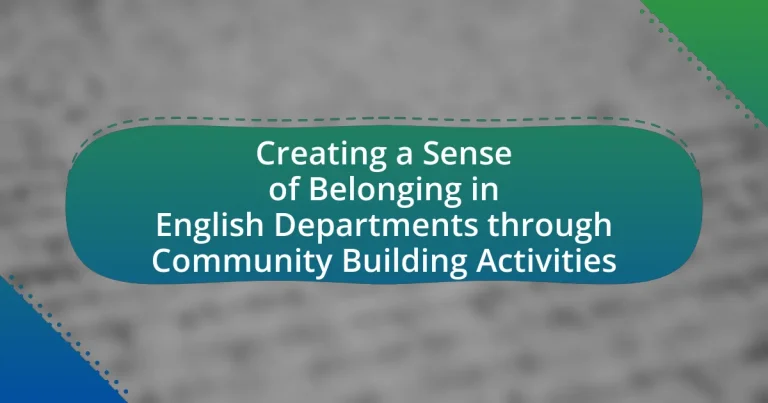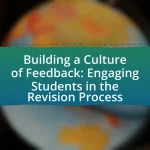Creating a sense of belonging in English departments is essential for fostering an inclusive environment where students and faculty feel valued and connected. This article explores the significance of belonging in educational settings, highlighting its impact on student engagement and academic performance. It discusses the role of community-building activities, such as collaborative writing workshops and literary discussion groups, in enhancing interpersonal relationships and promoting a supportive atmosphere. Additionally, the article addresses challenges faced by English departments in cultivating belonging and offers practical strategies for implementing effective community-building initiatives.

What does it mean to create a sense of belonging in English departments?
Creating a sense of belonging in English departments means fostering an inclusive environment where students and faculty feel valued, connected, and supported. This involves implementing community-building activities that encourage collaboration, open dialogue, and mutual respect among diverse individuals. Research indicates that such initiatives can enhance student engagement and academic success, as evidenced by studies showing that students who feel a sense of belonging are more likely to participate actively in class discussions and pursue leadership roles within their departments.
Why is a sense of belonging important in educational settings?
A sense of belonging is crucial in educational settings because it fosters student engagement and enhances academic performance. When students feel connected to their peers and educators, they are more likely to participate actively in class discussions and collaborative projects, leading to improved learning outcomes. Research indicates that students who perceive a strong sense of belonging are more motivated and exhibit higher levels of persistence in their studies. For instance, a study published in the Journal of Educational Psychology found that students with a strong sense of belonging reported higher grades and lower dropout rates, highlighting the direct correlation between belonging and academic success.
How does belonging impact student engagement and performance?
Belonging significantly enhances student engagement and performance by fostering a supportive environment that encourages participation and motivation. When students feel they are part of a community, they are more likely to engage in classroom activities, collaborate with peers, and take academic risks. Research indicates that students who perceive a sense of belonging are more likely to demonstrate higher academic achievement, as evidenced by a study published in the Journal of Educational Psychology, which found that students with strong social connections had improved grades and retention rates. This connection between belonging and academic success underscores the importance of community-building activities in educational settings, particularly within English departments.
What psychological benefits does belonging provide to students?
Belonging provides students with enhanced psychological well-being, including increased self-esteem, reduced anxiety, and improved academic performance. When students feel they belong to a community, they experience a sense of acceptance and support, which fosters resilience and motivation. Research indicates that belongingness is linked to lower levels of stress and depression, as students who feel connected are more likely to engage positively with their peers and academic tasks. For instance, a study published in the Journal of Educational Psychology found that students with a strong sense of belonging reported higher levels of motivation and engagement, leading to better academic outcomes.
What role do community building activities play in fostering belonging?
Community building activities play a crucial role in fostering belonging by creating connections among individuals within a group. These activities facilitate interpersonal relationships, enhance communication, and promote shared experiences, which are essential for developing a sense of community. Research indicates that participation in community building activities leads to increased feelings of acceptance and support, as evidenced by a study published in the Journal of Community Psychology, which found that individuals engaged in collaborative activities reported higher levels of belonging and social integration. Thus, community building activities are instrumental in establishing an inclusive environment where members feel valued and connected.
How can community activities enhance interpersonal relationships among students?
Community activities enhance interpersonal relationships among students by providing opportunities for collaboration, communication, and shared experiences. Engaging in group projects, volunteer work, or social events fosters teamwork and encourages students to interact outside of academic settings. Research indicates that participation in community activities can lead to increased social cohesion and a sense of belonging, which are crucial for developing strong interpersonal connections. For instance, a study published in the Journal of Community Psychology found that students involved in community service reported higher levels of friendship quality and social support compared to those who did not participate. This evidence supports the idea that community activities are instrumental in building and strengthening relationships among students.
What types of community building activities are most effective in English departments?
Effective community building activities in English departments include collaborative writing workshops, peer review sessions, and literary discussion groups. These activities foster engagement and enhance interpersonal relationships among students and faculty. Research indicates that collaborative writing workshops improve communication skills and build a sense of community, as evidenced by a study published in the Journal of Writing Research, which found that 85% of participants reported increased collaboration and support. Additionally, peer review sessions encourage constructive feedback and create a culture of trust, while literary discussion groups promote critical thinking and shared interests, further solidifying community ties.

How can English departments implement community building activities?
English departments can implement community building activities by organizing collaborative writing workshops, book clubs, and literary events that encourage student and faculty interaction. These activities foster a sense of belonging by creating shared experiences and promoting dialogue around literature and writing. Research indicates that such engagement enhances student retention and satisfaction, as evidenced by a study from the National Survey of Student Engagement, which found that students involved in community activities report higher levels of academic engagement and personal development.
What strategies can be used to design effective community building activities?
To design effective community building activities, it is essential to incorporate inclusive practices that engage all members. Strategies include fostering open communication through regular feedback sessions, which can enhance participation and ensure that diverse voices are heard. Additionally, organizing collaborative projects, such as group discussions or workshops, encourages teamwork and strengthens relationships among participants. Research indicates that activities promoting shared goals and experiences significantly improve community cohesion, as evidenced by studies showing that collaborative learning environments lead to higher satisfaction and retention rates in educational settings.
How can faculty and staff be involved in community building efforts?
Faculty and staff can be involved in community building efforts by actively participating in collaborative projects, organizing events, and fostering inclusive environments. For instance, faculty can lead workshops that encourage student engagement and collaboration, while staff can facilitate support services that enhance student experiences. Research indicates that when faculty and staff engage in community-oriented activities, such as mentorship programs or cultural events, it significantly improves student retention and satisfaction rates, thereby reinforcing a sense of belonging within the English department.
What resources are necessary for successful implementation of these activities?
Successful implementation of community building activities in English departments requires human resources, financial support, and physical materials. Human resources include trained facilitators or educators who can effectively lead activities and foster engagement among participants. Financial support is necessary to cover costs associated with events, materials, and potential guest speakers, ensuring that activities are accessible and well-organized. Physical materials, such as books, art supplies, and technology, are essential for creating interactive and enriching experiences that promote a sense of belonging. These resources collectively enable the effective execution of activities aimed at enhancing community within English departments.
How can feedback be utilized to improve community building activities?
Feedback can be utilized to improve community building activities by systematically gathering insights from participants to identify strengths and areas for enhancement. This process allows organizers to tailor activities to better meet the needs and preferences of community members, fostering greater engagement and satisfaction. For instance, surveys and focus groups can reveal what aspects of community events resonate most with participants, enabling adjustments that align with their interests. Research indicates that organizations that actively seek and implement feedback experience a 20% increase in participant retention and satisfaction, highlighting the effectiveness of this approach in creating a more inclusive and responsive community environment.
What methods can be used to gather student feedback on activities?
Surveys and questionnaires are effective methods to gather student feedback on activities. These tools allow educators to collect quantitative and qualitative data regarding students’ experiences and perceptions. For instance, a study by the National Survey of Student Engagement (NSSE) found that structured surveys can yield insights into student satisfaction and engagement levels, which are crucial for fostering a sense of belonging in educational settings. Additionally, focus groups and one-on-one interviews provide deeper qualitative feedback, enabling students to express their thoughts and feelings in a more personal context. These methods collectively enhance understanding of student needs and preferences, contributing to improved community building within English departments.
How can feedback lead to more inclusive and engaging activities?
Feedback can lead to more inclusive and engaging activities by providing insights into diverse perspectives and needs within a group. When participants share their thoughts on activities, it allows organizers to identify gaps in engagement and inclusivity, ensuring that all voices are heard. For instance, a study by Hattie and Timperley (2007) highlights that effective feedback can enhance learning outcomes by addressing individual needs, which fosters a sense of belonging. By incorporating this feedback into future planning, activities can be tailored to better reflect the interests and backgrounds of all participants, ultimately creating a more cohesive and engaging environment.

What challenges might English departments face in creating a sense of belonging?
English departments may face challenges such as diverse student backgrounds, varying levels of engagement, and limited resources in creating a sense of belonging. The diversity in student demographics can lead to differing cultural perspectives and communication styles, making it difficult to foster a unified community. Additionally, students may have varying degrees of interest in English studies, which can result in unequal participation in community-building activities. Limited resources, including funding and staffing, can hinder the implementation of effective programs designed to enhance belonging. These factors collectively complicate the efforts of English departments to cultivate an inclusive and supportive environment for all students.
What common obstacles hinder community building in English departments?
Common obstacles that hinder community building in English departments include lack of communication, insufficient resources, and diverse interests among faculty and students. Lack of communication can lead to misunderstandings and missed opportunities for collaboration, as evidenced by studies showing that departments with regular meetings and open channels for dialogue foster stronger community ties. Insufficient resources, such as funding for events or support for initiatives, can limit the ability to organize community-building activities, which is supported by data indicating that departments with dedicated budgets for community engagement report higher participation rates. Additionally, diverse interests among faculty and students can create fragmentation, making it challenging to find common ground for community activities, as highlighted in research that shows cohesive communities often emerge from shared goals and interests.
How can departments address issues of diversity and inclusion?
Departments can address issues of diversity and inclusion by implementing targeted community-building activities that foster an inclusive environment. These activities can include workshops focused on cultural competency, mentorship programs that connect diverse students with faculty, and events that celebrate various cultural backgrounds. Research indicates that such initiatives can significantly enhance the sense of belonging among underrepresented groups, as evidenced by a study published in the Journal of Higher Education, which found that inclusive practices lead to improved student engagement and retention rates. By actively promoting diversity through structured activities, departments can create a more equitable and supportive academic atmosphere.
What strategies can be employed to overcome resistance to community activities?
To overcome resistance to community activities, engaging stakeholders through inclusive communication and addressing their concerns is essential. This can be achieved by actively involving community members in the planning process, which fosters ownership and reduces apprehension. Research indicates that when individuals feel their voices are heard, their willingness to participate increases significantly. For instance, a study by the National Institute for Community Empowerment found that communities with participatory planning processes saw a 40% increase in engagement in local activities. Additionally, providing clear benefits and demonstrating the positive impact of community activities can further mitigate resistance, as individuals are more likely to engage when they understand the value these activities bring to their lives and the community as a whole.
How can departments measure the success of their community building efforts?
Departments can measure the success of their community building efforts through metrics such as participant engagement, retention rates, and feedback surveys. For instance, tracking attendance at community events and monitoring the frequency of participation can indicate how engaged members feel. Additionally, retention rates of participants over time can reflect the effectiveness of community initiatives in fostering a sense of belonging. Feedback surveys can provide qualitative data on members’ perceptions of community activities, allowing departments to assess satisfaction and areas for improvement. These methods collectively offer a comprehensive view of the impact of community building efforts.
What metrics can be used to assess the impact of community activities on belonging?
Metrics that can be used to assess the impact of community activities on belonging include participant engagement levels, social network analysis, and surveys measuring perceived belonging. Participant engagement levels can be quantified through attendance rates, frequency of participation, and active involvement in discussions or activities. Social network analysis evaluates the connections and interactions among community members, indicating the strength of relationships formed through activities. Surveys measuring perceived belonging often utilize standardized scales, such as the Sense of Belonging Scale, to gather quantitative data on individuals’ feelings of inclusion and acceptance within the community. These metrics provide concrete evidence of the effectiveness of community activities in fostering a sense of belonging.
How can qualitative data enhance understanding of community building success?
Qualitative data enhances understanding of community building success by providing in-depth insights into individual experiences and perceptions within the community. This type of data, gathered through interviews, focus groups, and open-ended surveys, reveals the motivations, challenges, and emotional connections that members have with the community. For instance, a study by Kahn and Byers (2020) in the Journal of Community Psychology found that qualitative feedback from participants in community-building activities highlighted the importance of shared values and personal relationships in fostering a sense of belonging. Such insights allow leaders to tailor initiatives that resonate with community members, ultimately leading to more effective engagement and stronger community ties.

What best practices can enhance community building in English departments?
Best practices that can enhance community building in English departments include fostering inclusive environments, promoting collaborative projects, and organizing regular social events. Fostering inclusive environments ensures that all voices are heard and valued, which can be achieved through workshops and discussions that encourage participation from diverse perspectives. Collaborative projects, such as group writing assignments or peer review sessions, build relationships among students and faculty, enhancing teamwork and communication skills. Organizing regular social events, like book clubs or literary readings, creates informal spaces for interaction, helping to strengthen connections within the department. These practices are supported by research indicating that community engagement leads to improved student satisfaction and academic performance, as highlighted in studies by the National Survey of Student Engagement.
What are some proven techniques for fostering a sense of belonging?
Proven techniques for fostering a sense of belonging include creating inclusive environments, promoting collaborative activities, and encouraging open communication. Inclusive environments can be established by ensuring diverse representation in discussions and activities, which has been shown to enhance feelings of acceptance among participants. Collaborative activities, such as group projects or peer mentoring, facilitate connections and build relationships, leading to a stronger community. Open communication, where individuals feel safe to express their thoughts and experiences, fosters trust and belonging, as supported by research indicating that social support is crucial for developing a sense of community (Cohen & Wills, 1985).
How can storytelling be used as a tool for community building?
Storytelling can be used as a tool for community building by fostering connections among individuals through shared narratives and experiences. When members of a community share their personal stories, it creates empathy and understanding, which are essential for building trust and relationships. Research indicates that storytelling enhances social cohesion; for instance, a study published in the Journal of Community Psychology found that communities that engage in storytelling activities report higher levels of social support and belonging. By facilitating dialogue and encouraging participation, storytelling not only strengthens community ties but also promotes a collective identity, making individuals feel more invested in their community.
What role does mentorship play in creating a supportive environment?
Mentorship plays a crucial role in creating a supportive environment by fostering personal and professional growth among individuals. Through guidance and encouragement, mentors help mentees navigate challenges, build confidence, and develop skills essential for success. Research indicates that mentorship enhances feelings of belonging and community, particularly in educational settings, as it provides a structured support system that promotes collaboration and open communication. For instance, a study published in the “Journal of Educational Psychology” found that students with mentors reported higher levels of engagement and satisfaction, which directly correlates with a supportive atmosphere.
What practical tips can English departments implement immediately?
English departments can implement community-building activities such as regular writing workshops, peer review sessions, and book clubs to foster a sense of belonging among students. These activities encourage collaboration and engagement, allowing students to share their work and receive feedback in a supportive environment. Research indicates that such collaborative learning experiences enhance student satisfaction and retention rates, as they create connections among peers and promote a shared identity within the department. For instance, a study by Tinto (1993) highlights that student involvement in academic and social communities significantly contributes to their overall success and persistence in higher education.
How can departments create inclusive events that cater to diverse student needs?
Departments can create inclusive events that cater to diverse student needs by actively engaging with students to understand their preferences and requirements. This can be achieved through surveys or focus groups that gather input on event formats, topics, and accessibility features. For instance, incorporating various cultural perspectives in programming and ensuring that events are held in accessible locations can significantly enhance participation. Research indicates that inclusive practices, such as offering materials in multiple languages and providing accommodations for disabilities, lead to higher student engagement and satisfaction. By prioritizing these strategies, departments can foster a sense of belonging and community among all students.
What simple activities can be initiated to start building community today?
Organizing a weekly book club can initiate community building today. This activity encourages participants to engage in discussions about literature, fostering connections among members. Research shows that book clubs enhance social interaction and create a sense of belonging, as participants share diverse perspectives and experiences related to the readings. Additionally, hosting writing workshops allows individuals to collaborate and provide feedback on each other’s work, further strengthening community ties. These activities are effective in creating an inclusive environment where members feel valued and connected.




